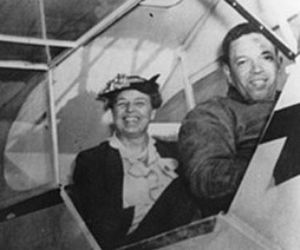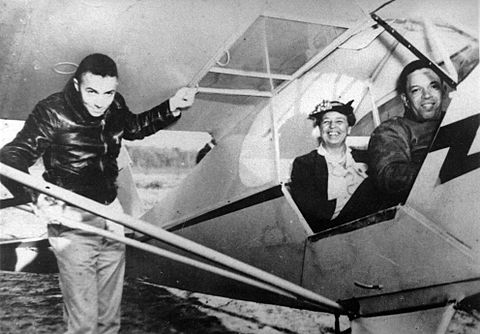C. Alfred "Chief" Anderson facts for kids
Quick facts for kids
C. Alfred "Chief" Anderson
|
|
|---|---|

April 11, 1941 C. Alfred "Chief" Anderson and First Lady Eleanor Roosevelt The Flight That Changed History.
|
|
| Born | February 9, 1907 |
| Died | April 13, 1996 (aged 89) |
| Monuments | Tuskegee Airmen National Historic Site, Tuskegee Alabama |
| Nationality | American |
| Known for | Father of Black Aviation |
| Spouse(s) | Gertrude Nelson Anderson |
| Relatives | Charles A. Anderson Jr., (Son) Christina L. Anderson (Granddaughter) |
| Awards | Honorary doctorate from Tuskegee University, 2013 Enshrinee National Aviation Hall of Fame, Featured on 70 cents Distinguished Americans postage stamp (2014), Induction into the National Center of Modeling and Simulation Hall of Fame (2018) |
| Aviation career | |
| Full name | Charles Alfred Anderson Sr., |
| First flight | Velie Monocoupe |
| Famous flights | Eleanor Roosevelt, and Chief Anderson's monumental flight |
| Flight license | 1929 Private Pilot License, Pennsylvania 1932 Transport Pilot License, Pennsylvania |
| Air force | ARMY Air Corps |
| Battles | Chief Flight Instructor for the Tuskegee Airmen WWII |
| Rank | Ground Commander |
Charles Alfred Anderson Sr. (born February 9, 1907 – died April 13, 1996) was an American aviator. He is often called the "Father of Black Aviation." He earned the nickname "Chief" because he was the main flight instructor for the famous Tuskegee Airmen.
Contents
Early Life and Dreams
Charles Alfred Anderson was born in Bryn Mawr, Pennsylvania. From a young age, he was fascinated by airplanes. He knew he wanted to fly more than anything. By the time he was 20, he had saved enough money for flying lessons.
However, in those days, it was very hard for a young Black man to find someone to teach him to fly. But Anderson did not give up. He went to aviation ground school to learn about planes. He also learned how airplanes work and spent time at airports. He picked up tips from white pilots whenever he could.
Learning to Fly
Anderson realized the only way he would learn to fly was to own his own airplane. He bought a Velie Monocoupe using his savings and money borrowed from friends and family. He eventually joined a flying club. However, they still did not offer him flight lessons.
So, Anderson taught himself! He would move his airplane around the field. He would speed up the engine and soon found himself in the air. With practice, he learned how to take off and land safely.
An experienced pilot named Russell Thaw joined the club. He didn't have a plane but wanted to visit his mother in Atlantic City. So, he made a deal with Anderson. Thaw would rent and fly Anderson's Monocoupe. In return, Anderson could come along. This helped Anderson gain valuable experience flying across the country. He earned his pilot's license in August 1929.
Anderson then wanted to get a special license to fly transport planes. Again, his race made it difficult. But help came from Ernest H. Buehl Sr., a German aviator. With Buehl's help, Anderson became the first African American to get an air transport pilot's license. This happened in February 1932.
Before World War II
On June 24, 1932, Anderson married his childhood sweetheart, Gertrude Nelson. They would later have two sons. In July 1933, Anderson met Dr. Albert E. Forsythe. Dr. Forsythe was a Black doctor and pilot. They both wanted to help other Black people get into aviation.
They decided to make record-setting flights to get attention. One of their most famous flights was the first round-trip flight across the United States by Black pilots. They flew from Atlantic City, New Jersey, to Los Angeles, California.
The two pilots made other "first flights" for Black aviators. They flew to Canada and all over the United States. In 1934, they flew their new plane, named "The Booker T. Washington," on a special tour. By September 1938, Anderson was teaching flying in Washington, D.C. He was hired as a flight instructor for a program at Howard University.
The Tuskegee Airmen and World War II
In 1940, Anderson was asked to join the Tuskegee Institute in Tuskegee, Alabama. He became the Chief Civilian Flight Instructor for a new Army pilot training program. Anderson created the training program and taught its first advanced class. His students gave him the nickname "Chief," and it stayed with him for the rest of his life.
On April 11, 1941, First Lady Eleanor Roosevelt was visiting Tuskegee. She saw planes flying and asked to meet the chief instructor. She told Anderson that she had heard "colored people couldn't fly." But she said it looked like he could! She then told him, "I'm just going to take a flight with you."
Anderson agreed, even though her security team was worried. After a 40-minute flight, Mrs. Roosevelt was very happy. She said, "Well, I see you can fly, all right!" This important flight became known as "The Flight That Changed History." Before this, Black people had never flown for the Army Air Corps. Her experience helped the Roosevelt administration. They had just started the Tuskegee Airmen Experiment. This experiment was to see if Black pilots could be trained for military service. Anderson went on to train other important military pilots. These included General Benjamin O. Davis Jr. and General Daniel "Chappie" James Sr..
By June 1941, the Army chose Anderson to be Tuskegee's Ground Commander. He was also the Chief Instructor for the 99th Pursuit Squadron. This was America's first all-Black fighter squadron. The 99th later joined three other squadrons to form the 332nd Fighter Group. They were known as the Red Tails. The 450 Tuskegee Airmen who fought in combat flew 1,378 missions. They destroyed 260 enemy planes. They also earned over 150 Distinguished Flying Crosses and many other awards.
After World War II
After the war, Anderson kept working in aviation. He provided flight training to both Black and white students. This was done under the G.I. Bill. In 1951, he trained Army and Air Force ROTC cadets. He also trained private students. He repaired aircraft and engines. He also sold planes in the Southeast and Southwest United States.
In 1967, Anderson helped start Negro Airmen International (NAI). This is the oldest African-American pilot organization in the world. Through NAI, Anderson created a summer flight academy for young people interested in aviation. He continued to teach students until 1989.
Death
C. Alfred "Chief" Anderson passed away on April 13, 1996, in Tuskegee, Alabama. He was 89 years old.
Awards and Honors
Throughout his life, Anderson received many important awards. On October 4, 2013, he was honored by being placed in the National Aviation Hall of Fame. This is one of the highest awards an aviator can receive in America. Christina Anderson, his granddaughter, accepted the award for him.
In March 2014, the United States Postal Service released a postage stamp honoring Alfred "Chief" Anderson. This stamp is part of the Distinguished Americans series. The stamp shows a picture of Anderson wearing a pilot's headgear from World War II.
See also
 In Spanish: Charles Alfred "Chief" Anderson para niños
In Spanish: Charles Alfred "Chief" Anderson para niños


